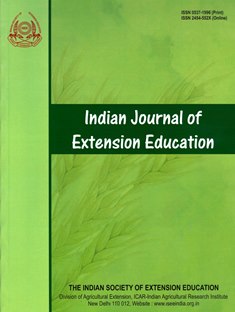Adoption of Soil Health Card by Farmers in Haryana: Perceptions, Challenges and Way Forward
DOI:
https://doi.org/10.48165/IJEE.2025.61104Keywords:
Soil health, Fertilizer, Haryana, Leasehold land system, Adoption, ImpedimentsAbstract
The Soil Health Card (SHC) program aims to enhance soil health by providing farmers with detailed information about the nutrient status of their soil. This study investigated farmers’ perceptions, challenges, and potential pathways to enhance the adoption of SHC recommendations in Haryana. The analysis was based on primary data collected through face-to-face interviews with SHC adopters and non-adopters, utilizing a pre-tested semi structured schedule in 2024. The findings revealed that farmers’ perceptions of the benefits of the SHC remained low. The perceived constraints in obtaining SHC scored higher than those associated with implementing its recommendations. The study identified the annual lease land system as a key factor driving the indiscriminate use of fertilizers in the state. Although the recent reduction in the per-bag quantity of urea decreased usage in Haryana, any further reduction in bag weight might result in increased fertilizer consumption. The study recommended the use of mobile soil testing vans and timely delivery of soil health cards to promote greater adoption.
Downloads
References
Aryal, J. P., Sapkota, T. B., Krupnik, T. J., Rahut, D. B., Jat, M. L., & Stirling, C. M. (2021). Factors affecting farmers’ use of organic and inorganic fertilizers in South Asia. Environmental Science and Pollution Research, 28(37), 51480–51496. https://doi.org/ 10.1007/s11356-021-13975-7
Bennett, J. M., & Cattle, S. R. (2014). Adoption of soil health improvement strategies by Australian farmers: II. Impediments and incentives. The Journal of Agricultural Education and Extension, 20(1), 107–131. https://doi.org/10.1080/1389224X. 2013.783494
Bora, K. (2022). Spatial patterns of fertilizer use and imbalances: Evidence from rice cultivation in India. Environmental Challenges, 7, 100452. https://doi.org/10.1016/j.envc.2022.100452
Chand, R., & Pavithra, S. (2015). Fertiliser use and imbalance in India. Economic and Political Weekly, 50(44), 98–104. https:// www.epw.in/journal/2015/44/special-articles/fertiliser-use-and imbalance-india.html
Dominati, E. J., Maseyk, F. J., Mackay, A. D., & Rendel, J. M. (2019). Farming in a changing environment: Increasing biodiversity on farm for the supply of multiple ecosystem services. Science of the Total Environment, 662, 703–713. https://doi.org/10.1016/ j.scitotenv.2019.01.268
Kaur, S., Kaur, P., & Kumar, P. (2020). Farmers’ knowledge of soil health card and constraints in its use. Indian Journal of Extension Education, 56(1), 28–32. https://epubs.icar.org.in/ejournal/ index.php/ijee/article/view/107801
Keesstra, S., Mol, G., de Leeuw, J., Okx, J., de Cleen, M., & Visser, S. (2018). Soil-related sustainable development goals: Four concepts to make land degradation neutrality and restoration work. Land, 7(4), 133. https://doi.org/10.3390/land7040133
Madhuri C. R., Naik, A., Kumar, A., & Padhy, C. (2024). Perception and adoption of soil health card by paddy growers of North Coastal Andhra Pradesh. Indian Journal of Extension Education, 60(4), 24–29. https://doi.org/10.48165/IJEE.2024.60405
Ohlan, R. (2021a). Farm reforms, protests and by-election in Haryana, Economic and Political Weekly, 56(21), 21–23. https:// www.epw.in/journal/2021/21/commentary/farm-reforms-protests and-election-haryana.html
Ohlan, R. (2021b). Managing quality of cereal grains. Economic and Political Weekly, 56(16), 4-5. https://www.epw.in/journal/2021/16/ letters/managing-quality-cereal-grains.html
Ohlan, R. (2021c). Economic viability of destroying crops. Economic and Political Weekly, 56(10), 5. https://www.epw.in/journal/2021/ 10/letters/economic-viability-destroying-crops.html
Patel, D. K., Kumar, A., & Dwivedi, S. (2023). Farmers’ challenges in adopting soil health card recommendations in Saharsa, Bihar. Indian Journal of Extension Education, 59(4), 154–156. https:/ /doi.org/10.48165/IJEE.2023.59431
Potapov, P., Turubanova, S., Hansen, M. C., Tyukavina, A., Zalles, V., Khan, A., & Cortez, J. (2022). Global maps of cropland extent and change show accelerated cropland expansion in the twenty-first century. Nature Food, 3(1), 19-28. https://doi.org/ 10.1038/s43016-021-00429-z
Purakayastha, T. J., Pathak, H., Kumari, S., Biswas, S., Chakrabarty, B., Padaria, R. N., & Singh, A. (2019). Soil health card development for efficient soil management in Haryana,India. Soil and Tillage Research, 191, 294-305. https://doi.org/10.1016/ j.still.2018.12.024
Rani, S. (2019). Assessment of the consequences of changing cropping pattern on land and water productivity: A case study of Haryana state, India. Agricultural Research, 8(2), 252–261. https://doi.org/ 10.1007/s40003-018-0388-5
Ravikishore, M., Johnson, M., & Supriya, P. (2021). Perception and adoption of soil health card (SHCS) recommendations by the farmers in Anantapuram district. Indian Journal of
Extension Education, 57(1), 170–175. https://doi.org/10.5958/ 2454-552X.2021.00018.9
Reddy, K. S., Shivay, Y. S., Kumar, D., Pooniya, V., Prasanna, R., Shrivastava, M., & Baral, K. (2024). Relative performance of urea and nano-urea in conjunction with zinc fertilization on growth, productivity, and nitrogen use efficiency in spring wheat. Journal of Soil Science and Plant Nutrition, 24, 3593–3609. https://doi.org/10.1007/s42729-024-01780-3
Singh, B. P., Kumar, V., Chander, M., Reddy, M. B., Singh, M., Suman, R. S., & Yadav, V. (2023). Impact of soil health card scheme on soil fertility and crop production among the adopted farmers. Indian Journal of Extension Education, 59(1), 122–126. http:/ /doi.org/10.48165/IJEE.2023.59125
Veluguri, D., Ramanjaneyulu, G. V., & Jaacks, L. (2019). Statewise report cards on ecological sustainability of agriculture in India. Economic and Political Weekly, IV(26&27), 19–27. https:// www.epw.in/journal/2019/26-27/review-rural-affairs/statewise report-cards-ecological-sustainability.html
Downloads
Published
Issue
Section
License

This work is licensed under a Creative Commons Attribution-NonCommercial-NoDerivatives 4.0 International License.

